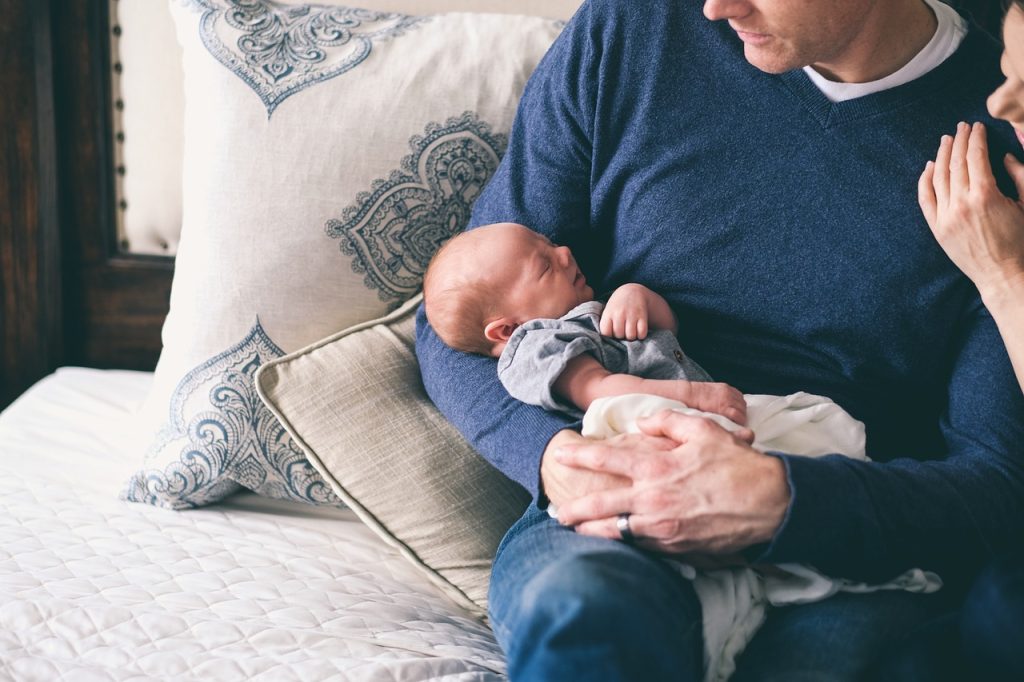Getting your baby to sleep peacefully can be a challenge, but a calming bedtime routine can make all the difference. In this article, you will discover simple yet effective tips on how to create a soothing routine that will help your baby wind down and prepare for a restful night’s sleep. From gentle massages to cozy pajamas, incorporating these techniques into your evening ritual will not only create a tranquil environment but also promote healthy sleep habits for your little one. So, get ready to embark on a journey to bedtime bliss for your baby!
Establishing a Consistent Bedtime
Choose a regular bedtime
Choosing a regular bedtime for your baby is essential for establishing a consistent routine. It is recommended to select a time that allows your little one to get the appropriate amount of sleep based on their age. Newborns may need more sleep, while older babies require slightly less. By setting a consistent bedtime, you provide structure and predictability, which can help your baby feel secure and prepare their body for a good night’s rest.
Stick to the same routine every night
Consistency is key when it comes to establishing a bedtime routine for your baby. By following the same steps in the same order every night, you create a sense of familiarity and signal to your little one that it is time to wind down. This routine can include activities such as a warm bath, feeding, reading a bedtime story, and cuddling. Sticking to this consistent routine will help your baby understand the expectations and feel secure in knowing what comes next.
Create a soothing environment in the bedroom
Creating a soothing environment in your baby’s bedroom is crucial for promoting relaxation and sleep. Make sure the room is comfortably cool, as a slightly lower temperature can aid in better sleep. Use blackout curtains to block out any excess light that may disrupt your baby’s sleep. Soft, muted colors on the walls and a cozy crib or bassinet can also contribute to a calming atmosphere. As your baby begins to associate their bedroom with relaxation and sleep, they will feel more at ease when it’s bedtime.
Creating a Relaxing Pre-Bedtime Routine
Start winding down at least an hour before bedtime
Begin winding down your baby’s activities at least an hour before their targeted bedtime. This allows their body and mind to transition from active play to a more relaxed state. By gradually reducing stimulation, your baby will be better prepared for a restful night’s sleep. During this winding-down period, avoid any high-energy or exciting activities that may make it difficult for your baby to calm down.
Engage in calm activities
Incorporate calm activities into your baby’s pre-bedtime routine to promote relaxation. This could involve gentle play, such as quietly stacking blocks or playing with soft toys. You could also introduce a soothing lullaby or sing softly to your baby. By focusing on activities that are calming and quiet, you will help your baby’s body and mind unwind, setting the stage for a peaceful sleep.
Avoid stimulating activities
When creating a bedtime routine for your baby, it is important to avoid activities that may stimulate or excite them. This includes activities like rough play, loud music, or engaging with electronic devices such as smartphones or tablets. These activities can interfere with your baby’s ability to wind down and can make it harder for them to fall asleep. Instead, opt for activities that promote a sense of calmness and relaxation.
Limit screen time
It is widely recommended that babies under the age of 18 months avoid screen time altogether, while toddlers should have limited exposure to screens. The blue light emitted by screens can disrupt your baby’s sleep patterns and make it more difficult for them to fall asleep. Instead of relying on screen time to entertain your baby before bed, choose screen-free activities that encourage relaxation and engagement with the physical world around them.

This image is property of pixabay.com.
Bath Time: A Calming Ritual
Make bath time a part of the routine
Incorporating bath time into your baby’s bedtime routine can be a soothing and enjoyable experience for both of you. A warm bath can help relax your baby’s muscles and set the stage for a restful night’s sleep. Make sure to keep the water temperature comfortable and use gentle, baby-friendly products that will not irritate their delicate skin. By consistently making bath time a part of the routine, your baby will come to associate it with winding down and getting ready for bed.
Use warm water and gentle products
When getting your baby ready for bed, it is important to use warm water for their bath. Warm water can help relax their muscles and release any tension from the day. Additionally, choose gentle baby-friendly products that are free from harsh chemicals or fragrances. These gentle products will help keep your baby’s skin clean and moisturized while avoiding any potential irritation. By using warm water and gentle products, you create a soothing and comforting bath time experience for your baby.
Play soft music or sing lullabies
As you prepare your baby for bed, consider incorporating soft music or singing lullabies into their bedtime routine. Gentle, calming melodies can help create a serene atmosphere and signal to your baby that it is time to relax and prepare for sleep. Whether you choose to play soft instrumental music or sing soothing lullabies yourself, the sound of music can provide a sense of comfort and tranquility for your baby.
Provide a calming massage after the bath
After the bath, consider incorporating a calming massage into your baby’s bedtime routine. Massaging your baby with gentle, soothing strokes can help relax their muscles and promote a sense of calmness. Use a hypoallergenic and baby-friendly oil or lotion to glide your hands smoothly over your baby’s skin. This gentle touch can provide a soothing sensation and further enhance the relaxation process before bedtime.
Feeding and Snuggle Time
Feed your baby before bedtime
Feeding your baby before bedtime is an essential part of their bedtime routine. By ensuring they are well-fed, you can help prevent hunger from waking them during the night. Whether you breastfeed or bottle-feed, try to create a peaceful and quiet environment during this time. Minimize distractions and focus on creating a comforting atmosphere as you bond with your baby.
Create a cozy atmosphere
During feeding time and snuggle time before bed, it is important to create a cozy atmosphere for your baby. Dim the lights, or use a soft nightlight to provide a gentle glow. Play soft music or white noise in the background to help drown out any external noise that may disturb your baby. By creating a serene ambiance, you are setting the stage for a peaceful transition from feeding to sleep.
Offer comfort through gentle snuggling
After feeding, take some time to snuggle with your baby. Gentle and nurturing touch can provide a sense of security and comfort for your little one. Hold your baby close, rock them gently, or use gentle strokes on their back. This physical connection can help your baby feel loved and calm as they drift off to sleep.
Avoid overfeeding or bedtime snacks
While it is important to ensure your baby is well-fed before bed, it is equally essential to avoid overfeeding or providing bedtime snacks. Overfeeding can lead to discomfort and may disrupt your baby’s sleep. On the other hand, starting a habit of bedtime snacking can create a dependency on food to fall asleep. Stick to a balanced and appropriate feeding routine to establish healthy sleep patterns for your baby.

This image is property of pixabay.com.
Dressing for Sleep
Choose comfortable sleepwear
Selecting the right sleepwear for your baby is important for their comfort throughout the night. Opt for loose-fitting, breathable materials such as cotton that allow your baby’s skin to breathe. Avoid any accessories or clothing items that could pose a safety risk, such as strings or loose buttons. By choosing comfortable and safe sleepwear, you ensure that your baby can move freely and sleep comfortably.
Consider the room temperature
When dressing your baby for sleep, it is crucial to consider the room temperature. Babies sleep best in a slightly cooler environment, ideally between 68 to 72 degrees Fahrenheit (20 to 22 degrees Celsius). Dress your baby in layers, so you can easily adjust their clothing if the temperature fluctuates throughout the night. A comfortable and consistent room temperature helps promote a restful night’s sleep.
Use appropriate bedding
Choose appropriate bedding for your baby’s crib or bassinet to ensure their safety while they sleep. Use a firm mattress with a fitted sheet that fits securely and without any gaps. Avoid using pillows, blankets, or stuffed animals in the crib, as they can pose suffocation hazards. Instead, opt for a lightweight sleep sack or wearable blanket that provides warmth without the need for loose bedding.
Ensure safety in the crib
Safety is paramount when it comes to your baby’s sleep environment. Keep the crib clear of any potential suffocation hazards, such as pillows, blankets, or stuffed animals. Avoid using crib bumpers, as they have been associated with an increased risk of accidents. Make sure the crib meets current safety standards and regularly inspect it for any loose screws or damaged parts. By ensuring a safe sleep environment, you can have peace of mind while your baby sleeps.
Dimming Lights and Soothing Sounds
Lower the intensity of lights
As bedtime approaches, it is important to lower the intensity of the lights in your baby’s surroundings. Bright lights can interfere with your baby’s internal clock and make it harder for them to fall asleep. Consider using dimmers or soft lighting to create a relaxing atmosphere. By gradually dimming the lights, you signal to your baby’s body that it is time to wind down and prepare for sleep.
Use nightlights or dimmers
Nightlights can be a helpful addition to your baby’s sleep environment. They provide a gentle and comforting glow that can help alleviate any fear of the dark your baby may have. Opt for nightlights with a soft, warm light that won’t disrupt your baby’s sleep. Additionally, consider using dimmers on any overhead or bedside lights to further create a soothing environment.
Play white noise or soft music
White noise or soft music can be incredibly soothing for babies as they fall asleep. White noise machines or smartphone apps that imitate the sounds of rainfall, waves, or gentle hums can help mask any disruptive noises and create a consistent and calming background sound. Alternatively, soft instrumental music or lullabies can provide a melodic and peaceful atmosphere for your baby’s sleep.
Experiment with calming nature sounds
In addition to white noise or soft music, consider experimenting with calming nature sounds for your baby’s sleep environment. The sound of a gentle rainforest, birds chirping, or a bubbling brook can create a serene ambiance that promotes relaxation and sleep. Explore different options, such as sound machines or audio recordings, and observe how your baby responds to different sounds.

This image is property of pixabay.com.
Establishing a Bedtime Story Routine
Read to your baby every night
Reading to your baby is a wonderful way to introduce them to the joys of storytelling and language. Make it a nightly routine to read a bedtime story to your little one. This special time together not only helps create a bond between you and your baby but also provides a comforting and relaxing activity before sleep. Settle into a cozy spot, snuggle up, and let the gentle rhythm of your voice guide your baby into dreamland.
Choose soothing and age-appropriate stories
When selecting bedtime stories, opt for soothing and age-appropriate books. Look for books with simple and repetitive language, soft illustrations, and gentle themes. Bedtime stories should engage your baby’s imagination and help them unwind. Avoid stories with overly exciting or energetic plotlines, as they may stimulate your baby instead of soothing them. Choose books that are calming and promote a peaceful mindset.
Use a quiet and gentle voice
As you read to your baby, use a quiet and gentle voice to further enhance the relaxing atmosphere. Your soft tone will help signal to your baby that it is time to wind down and settle for sleep. Allow pauses in your reading to give your baby a chance to absorb the story and transition into a tranquil state. Your soothing voice will become a familiar sound that your baby associates with bedtime and comfort.
Encourage relaxation and imagination
Bedtime stories provide an opportunity to encourage relaxation and stimulate your baby’s imagination. Choose stories that have calming and positive messages, weaving in themes of comfort, love, and security. Allow your baby’s mind to wander and imagine the scenes described in the story. By providing a space for relaxation and imagination, you are setting the stage for a peaceful and restorative sleep.
Promoting Comfort and Security
Provide a special lovey or stuffed toy
Introducing a special lovey or stuffed toy can provide comfort and security for your baby during sleep time. Choose a soft and safe toy that your baby can cuddle with, such as a small blanket or a stuffed animal. Having a familiar object nearby can help soothe your baby if they wake up during the night. Avoid using toys with small parts or loose threads to ensure your baby’s safety.
Use a pacifier if desired
If your baby finds comfort in using a pacifier, you can incorporate it into their bedtime routine. The act of sucking on a pacifier can help soothe and relax your baby, promoting a sense of calmness. However, it is important to consider your baby’s individual needs and consult with your pediatrician regarding pacifier use. If you choose to use a pacifier, aim to wean your baby off it by around six months of age to prevent any potential dental issues.
Create a cozy sleep environment
To promote comfort and security, create a cozy sleep environment for your baby. Ensure the room temperature is comfortable, with appropriate bedding and soothing lighting. Soft, breathable fabrics in their sleepwear and bedding can enhance their level of comfort. Additionally, consider using a white noise machine or a fan to create a gentle and consistent sound that can drown out any sudden noises. A cozy sleep environment contributes to a sense of calmness and eases your baby into sleep.
Respond to your baby’s needs promptly
When it comes to promoting comfort and security, it is important to respond to your baby’s needs promptly. Whether they need a diaper change, a sip of water, or a gentle reassurance, attending to their needs shows them that you are there for them. By promptly addressing your baby’s needs, you create a sense of trust and security, allowing them to relax and sleep more soundly.
Maintaining Consistency During Night Wakings
Follow the same routine during night wakings
Babies often experience night wakings, and it is important to maintain consistency during these periods. If your baby wakes up during the night, try to follow the same routine that you establish during bedtime. Use low lighting, speak in a quiet and soothing voice, and engage in calm activities such as a gentle feed or a diaper change. By providing a consistent and familiar routine, your baby will understand that it is still nighttime and signal to their body that it is time to go back to sleep.
Avoid stimulating your baby
During night wakings, it is crucial to avoid stimulating your baby. Keep the environment calm and quiet, avoiding any bright lights or engaging activities. Engage in minimal interaction and use a soft voice to comfort and reassure your baby. By minimizing stimulation, you create the optimal conditions for your baby to return to sleep without becoming fully awake.
Provide comfort and reassurance
When your baby wakes up during the night, providing comfort and reassurance is essential. Hold your baby close, gently stroke their back, or offer a soothing voice to let them know you are there. Comforting touches and gentle reassurance help your baby feel safe and secure, allowing them to drift back to sleep more easily.
Avoid unnecessary feeding
While feeding may be necessary if your baby is hungry during the night, it is important to evaluate whether a night feeding is truly needed or if your baby is capable of soothing back to sleep without it. As your baby grows, your pediatrician can guide you on appropriate feeding patterns to ensure they are meeting their nutritional needs during the day. Avoid unnecessary feedings that may create a reliance on food to fall back asleep, as this can disrupt their sleep patterns.
Monitoring and Adjusting the Bedtime Routine
Observe your baby’s response
As you establish a bedtime routine for your baby, it is essential to observe their response and evaluate its effectiveness. Pay attention to how your baby settles into sleep, the length and quality of their sleep, and any noticeable changes in their behavior. By closely monitoring their response, you can gain insights into what elements of the routine are working well and what may need adjustment.
Make adjustments as needed
Every baby is unique, and what works for one may not work for another. As you observe your baby’s response to the bedtime routine, be open to making adjustments as needed. This may involve shifting the timing of certain activities, experimenting with different soothing techniques, or adapting the routine to better suit your baby’s individual needs. Flexibility and willingness to adapt will help ensure a successful and calming bedtime routine for your baby.
Be patient and consistent
Establishing a calming bedtime routine takes time and patience. It may take a few nights or even weeks for your baby to fully adjust and find comfort in the routine. Stay consistent and patient, sticking to the established routine even if there are initial challenges. Consistency is key in helping your baby develop healthy sleep habits and finding comfort in their bedtime routine.
Seek professional advice if necessary
If you are experiencing significant challenges in establishing a calming bedtime routine for your baby, do not hesitate to seek professional advice. Your pediatrician or a qualified sleep consultant can provide guidance tailored to your baby’s specific needs. They can help address any concerns or difficulties you may be facing and offer strategies to establish a routine that promotes a peaceful and restful sleep for your little one.
In conclusion, creating a calming bedtime routine for your baby is a valuable investment in their sleep and overall well-being. By establishing a consistent bedtime, engaging in relaxing pre-bedtime activities, and ensuring a cozy sleep environment, you provide your baby with the tools to wind down and embrace a restful night’s sleep. Remember to be patient, monitor your baby’s response, and make adjustments as needed. With time, a calming bedtime routine will become a cherished and comforting part of your baby’s daily routine.








